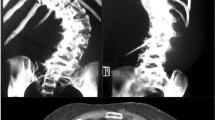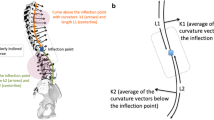Summary
There is a simple morphological interrelation between the growing spinal cord-nerve root complex and the vertebral column, not unlike that between the growing brain and skull. The shape of the enveloping vertebral skeleton mirrors the anatomical features of the enclosed neural contents. During the cranio-caudally directed growth, spurts of elongation of the vertebral column may be too rapid for the slower growth rate of the spinal cord and nerve roots. The resulting disproportion of growth between spine and nervous system is compensated for by adaptive scoliotic curvature of the otherwise normally growing spine. The proposed pathogenetic concept readily explains the main clinical features of the deformity and is supported by a spring model experiment.
Similar content being viewed by others
References
Breig A, (1978) Adverse mechanical tension in the central nervous system. Almqvist a Wiksell, Stockholm
Clara M (1959) Anatomie des Nervensystems. Barth, Leipzig
Hamilton JJ, Schmidt AC (1975) Scoliosis with spontaneous transposition of the spinal cord. J Bone Jt Surg [Am] 57: 474–477
Holmdahl DE (1918) Utvecklingen av den kaudala delen av ryggmärgen hos människan. Thesis, Lund
Knutsson F (1961) Growth and differentiation of the postnatal vertebra. Acta Radiol 55:401–408
Lloyd Roberts GC, Pincott JR, McMeniman P, Bayley I, Kendall B (1978) Progression in idiopathic scoliosis. J Bone Jt Surg [Br] 60:451–460
Lorenz A (1886) Pathologie und Therapie der seitlichen Rückgratverkrümmungen (Scoliosis). Hölder, Wien
Movsovic IA (1964) Skolioz (Russian). Medicina, Moskva
Nicoladoni v C (1894) Architektur der kindlichen Skoliose. Denkschr Kaiserl Akad Wissensch Wien 61:17–44
Roth M (1968) Idiopathic scoliosis caused by a short spinal cord. Acta Radiol Diagn 7:257–270
Roth M (1969) Idiopathische Skoliose: Eine Sonderform der vertebro-neuralen Wachstumsdisproportion. Z Orthop 109: 37–46
Roth M, Krkoška J, Toman I (1976) Morphogenesis of the spinal canal, normal and stenotic. Neuroradiology 10:277–286
Rubinstein HS (1936) The effect of the growth hormone upon the brain and brain weight-body weight relation. J Comp Neurol 64:469–496
Theiler K (1963) Embryonale und postembryonale Entwick-lung des Schädels. In: Handbuch der medizinischen Radiologie, Bd VII/1, Springer, Berlin Göttingen Heidelberg, p 20
Töndury G (1958) Entwicklungsgeschichte und Fehlbildungen der Wirbelsäule. Hippokrates, Stuttgart
Author information
Authors and Affiliations
Rights and permissions
About this article
Cite this article
Roth, M. Idiopathic scoliosis from the point of view of the neuroradiologist. Neuroradiology 21, 133–138 (1981). https://doi.org/10.1007/BF00339521
Received:
Issue Date:
DOI: https://doi.org/10.1007/BF00339521




